April: Bells and Kuzu
On the 27th of April, Dō-jō-ji, 道成寺, Way-attain-temple, in Wa-ka-yama, 和歌山, Japan-poem-mountain, observes the tale of a monk’s fatal encounter with a monstrous snake, Ō-rochi, 大蛇, Great-snake. The snake is a woman, shunned by a Buddhist monk, transformed by her jealousy. A popular event, it enacts the incident. An enormous snake puppet, 21 meters, or 70 shaku, long giant with a fearsome dragon-like head, is supported by about 70 people. It climbs a hill to the temple amid a throng of on-lookers. It coils around the replica of the temple bell, and when the bell is turned over reveals a white skeleton of the monk. The incense from the bell kō-gō, 香合, incense-gather, is a reminder of the dragon flames that killed the man.
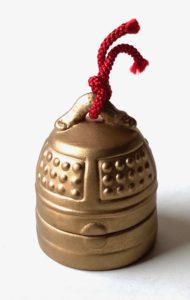
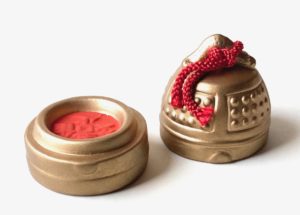
Kō-gō, 香合, incense-gather: soft paste ceramic in the form of a bon-shō, 梵鐘, buddhist-bell, with handle in the form of a snake, cold-painted gold; 2 sun kujira-jaku. The kōgō is intended to hold neri-kō, 練香, knead-incense, to be used with the ro. A kan-shō, 喚鐘, call-bell, was used to summon guests back into the Tearoom during a Chaji.
The kōgō, 香合, incense-gather, is modeled on a temple bell in the form of a do-suzu, 土鈴, earth-bell, which would have been hollow, containing a small pellet to make a noise when shaken, hence the red cord to shake it. The kōgō is also designed to look like a container for shu-niku, 朱肉, vermillion-flesh (ink paste), with an interior that has a relief design of a coin with the Zen motto; ‘Ware tada taru shiru’, 吾唯足知, ‘I only know sufficiency’. Each of the four Kanji employs the same Kanji radical, kuchi, 口, mouth.
The motif is inspired by the Nō play, ‘Dō-jō-ji’, 道成寺, Way-become-temple, and the Kabuki play, ‘Musume Dō-jō-ji’, 娘道成寺, Girl Way-become-temple, in which a young woman in jealousy transforms into a snake clinging to the temple bell, which conceals a wayward monk.
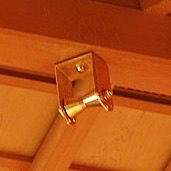
The Nō play, ‘Dōjōji’, named for the temple in which the drama is set, requires that a large, silk fabric model of the temple’s bell by a metal pulley, ka-sha, 滑車, slide-wheel, in the middle of the ceiling of the stage. It is the only major permanent prop in the Nō theater. It may remind one of the permanent hook in the Tearoom ceiling to hang a kettle over the ro. There is a small metal ring, wa, 環, on an adjacent post to raise, lower, and secure the rope of the bell.
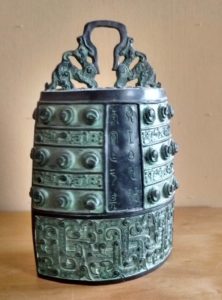
Every Buddhist temple has a bon-shō, 梵鐘, buddhist-bell, that is similar to the the kōgō incense holder, pictured above. The temple bell is used to announce the time of day and the time for events in the temple. Each bell, kane, 鐘, has the lug on the top to hang it, which is usually in the form of one or two dragons. The dragon or serpent is known as ryū, 竜, ryō, tatsu, 龍. The bell of a temple may be hung from the eave of a building, or in a specifically constructed shō-ro, 鐘楼, bell-tower. The raised tower is usually built with four corner posts supporting a roof, with a large metal hook in the ceiling. The bell is struck with a suspended horizontal tree trunk from the outside. In the Tearoom, a similar hook in the ceiling above the ro, is used to hang a kettle. Likewise, in a tokonoma, there is a hook in the ceiling to hang a flower container. Both the Tearoom and the tokonoma, with their four supporting corner posts, are similar to a Buddhist bell tower. The kanshō that is struck at night to summon guests back into the Tearoom, may be hung in the room from a separate ceiling hook. The Tearoom and the tokonoma hooks are identified with a hiru, 蛭釘, leech-hook. Perhaps the origin of the hiru-kugi is found in the dragon associated with the temple bell. There are kama for Tea that are in the form of a temple bell.
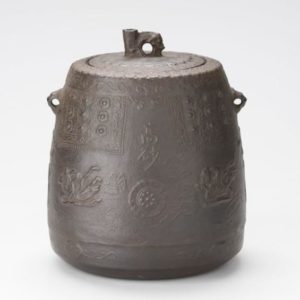
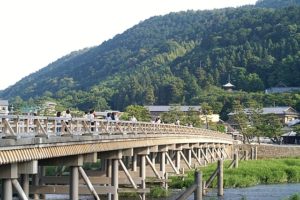
On the 13th of April a celebration of girls becoming women at the age of 13, Jū-san Mairi, 十三詣り, Ten-three (shrine)Visit, is observed is held at Hō-rin-ji, 法輪寺, Law-ring-temple, in the area of Arashi-yama, 嵐山, Storm-mountain. The temple is located where, in the 300s, there was a shrine Kazu-no-i-gū, 葛野井宮, Kuzu-’s-well-palace dedicated to the San-kō Myō-jo-son, 三光明星尊, Three-light-star-lords. The shrine was greatly worshiped by people who made crafts and arts as their profession.
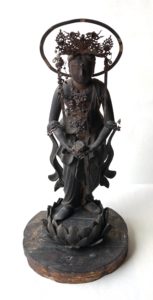
The principle image of Hōrinji is a figure of Sen-ju Kan-non Bo-satsu, 千手観音菩薩, Thousand-hand See-sound Grass-buddha, who is accompanied by images of Fu-dō Myō-ō, 不動明王, No-move Bright-king, on his right, and on his left, Bi-sha-mon-ten, 毘沙門天, Help-sand-gate-heaven (deva). Both deities serve Senju Kannon. Hōrinji was created where there had been an ancient and revered shrine, Kazu-no-i-gū, 葛野井宮, Kuzu-field-well-palace.
In 713, Gen-mei Ten-nō, 元明天皇, Origin-bright Heaven-emperor, asked the monk Gyō-ki (行基), founder of mapping in Japan, to build a temple as a prayer for bountiful harvests. He chose a revered shrine called Kazu-no-i-gū, 葛野井宮, Kuzu-field-well-palace. Kazu-no, 葛野, kazu is usually read kuzu, and 葛野, is also read kado-no. Kadono is a town east of Hōrinji. The name Kuzuno is thought to have originated from the expansive fields of kuzu grown in that area west of Kyōto. In 794 AD, Kan-mu Ten-nō, 桓武天皇, Marking post-warrior Heaven-emperor, moved the capital to be located near Kazuno County, and established Heian-kyō.
Kuzu roots can be most challenging to get out of the ground. In the Jōmon ji-dai, 縄文時代, Rope-mark time-era, people needed stone axes which were for digging up yams, tubers and other roots and rhizome vegetables like kuzu. Then the plants then needed grinding with pitted stones and grinding slabs for processing the roots into edible foods.
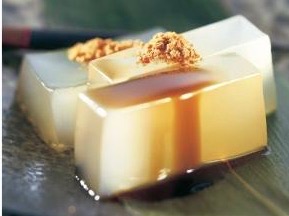
Kuzu-yu, 葛湯, kuzu-hot water, is a winter drink of hot water mixed with powdered kuzu. The beverage is made by finely shredding the roots, and drying them for twenty days in the shade, then heat-dried for ten days, and ground to a powder. The powdered kuzu is mixed with hot water and cooked until a desired thickness. For flavoring, jujubes can be added to the boiling liquid. It is curious that jujube in Japanese is the natsume, 棗, which is the model for and name of the most familiar tea container in Chanoyu.
The Kanji for kuzu, 葛, is also read tsuzura, katsu, kachi, etc. It is also read kazura meaning a creeping plant, vine, liana, etc. Kuzu-kiri, 葛切り, kuzu-cut, are transparent, almost flavorless noodles. Kuzu, Japanese ‘arrowroot’ starch is used in making a multitude of foods, and most often used as a liquid thickener.
The vines are left to ferment in soil or in the leaves of susuki, 薄 , eulalia, pampas grass for 2 to 3 days. The kuzu surface becomes soft, then is washed in a river, and only the clean fibers are taken out of the water. Susuki is one of the seven flowers of autumn.
Kuzu vines are mowed during summer from June to August. The kuzu vine core is woven into baskets. In addition, the root, which can grow as large as a human being, is powdered, and made into a medicine called ka-kkon-tō, 葛根湯, kuzu-root-hot water. The leaves are also used as a dye for a deep green color.
In China, kuzu textiles have been found dating back six thousand years, making it the earliest such plant fiber fabrics. Chinese kuzu textile technology can be summarized into six steps: picking kuzu, soaking, boiling, drying, harvesting, and weaving kuzu.
There may an extraordinary coincidence between the Kanji for kuzu, 葛, and an aspect of processing the plant for powdering the root. The Kanji is composed of the grass radical, 艹, which can represent the number 20, and nichi, 日, sun, day, and kyō, 匈, turmoil. The latter Kanji is composed of kyō, 凶, misfortune, and tsutsumu, 勹, wrap. Shredded, dried, roasted, and powdered may suggest ‘turmoil’, and for twenty and then days. Just coincidence!
A special fabric is called kuzu-fu, 葛布, kuzu-cloth, Japanese ‘arrowroot’ fiber, has a long history, and is made of bast fiber taken from the kuzu plant for weft and woven by hand. Possibly as early as the neolithic period, kuzu cloth was made in the Kofun period 700s. Hemp was one of the earliest fibers used to make cloth in Japan. Cotton was imported from China in the 15th century.
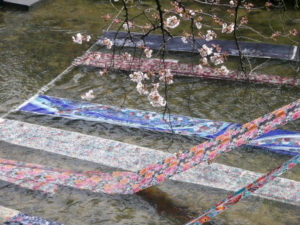
Making cloth out of plant fibers requires much water. Japan had and has plenty of water, and flowing in rivers and streams. Kuzu vines are boiled, soaked in water, and fermented, after which fibers are taken out and spun to form kuzu threads. Fabrics are rinsed in flowing water. In Kyōto in the 1970s, dyed fabrics were rinsed in Kyōto’s the Ka-mo Gawa, 加茂川, Increase-growth River, which was a colorful and fascinating sight, although pollution laws stopped the practice.
The words Kamo Gawa are also written with the Kanji, 鴨川, Wild duck River. Kamo, 加茂, is the name of a clan which occupied the northern part of Kyōto area, that is the source of the Kamo river waters. Another such clan, like the Ya-saka, 八坂, Eight-hills, which occupied the east side of the Kyōto area, its name attached to Ya-saka Jin-ja, 八坂神社, Eight-hills God-shrine. Much of the southern part of the Kyōto area in the Heian period was swampy and uninhabitable, due in part to the confluence of several rivers, and flat land.
Clothing made of plant fibers was not the only course. Japan like China is known for its silk, which is made of a kind of fiber spun by ‘silkworm’ moth worms that eat kuwa no ha, 桑の葉, mulberry leaves. Mulberry leaves were so important that the Chinese got them from Japan. Buddhist priests are called Sō-mon, 桑門, Mulberry-gate. Wool for clothing came rather late in Japan’s history.
The Buddhist monk, Ei-sai, 栄西, Flourish-west, who introduced Zen and tea rites from China, detailed in his account, ‘Ki-ssa Yō-jō-ki’, 喫茶養生記, Drink-tea Nurture-life-account, that drinking ‘tea’ made with leaves of the mulberry, Morus alba, leaves was extremely beneficial, which he also said of tea, Camellia sinensis. The Morus family includes figs. The Buddha meditated under a kind of fig tree, and became enlightened, and Adam and Eve clothed themselves with fig leaves, and gained knowledge of the world. Gen-gen-sai, 玄々斎, Mystery-mystery-abstain, XI Iemoto of Urasenke chose a kaji no ha, 梶の葉, oar ’s leaf, to use as lid for a mizusashi in the Tea presentation called ha-buta, 葉蓋, leaf-lid. The kaji leaf is of the Morus papyrifera L. is a tree in the family Moraceae, the bark of which is used to make paper, which gives it the name of paper mulberry.
Clothing made of wool from sheep was not a Japanese custom, except in the north of the country. But sheep weren’t native to Japan, and were imported only in the late 19th century. Japan’s need for wool, lead, in part, to war with China. Hokkaido in the north, territory of the Ainu, had bears, but they were, and are, sacred to the Ainu, and therefore rarely used for clothing. They traditionally wore clothing made of elm bark, and other plant fibers. For winter clothing, skins of dog, bear, deer, wolf, or fox were and are worn.
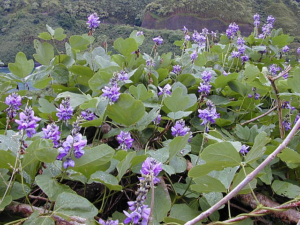
Animals for making clothing is generally a custom of herding people, always on the move for grazing, whereas plant fiber is for farmers who remain in one place to tend the growing plants. Japan used kuzu, 葛, kuzu, in neolithic times. It is a fast-growing plant and will take over if unattended. Kuzu is one of the flowers often mentioned in the Manyoshū, and is one of the aki no nana-kusa, 秋の七草, autumn ’s seven-grasses.
Because of the importance of kuzu for making fabric and food was so intrinsic in ancient Asia, Chinese and Korean visitors came to Japan and worshipped at the ancient Kuzunoi–gū. In the 700s, an ancient clan from China called the Hata, 秦, Qin (dynasty), migrated to Japan. ‘Hata’ became the name given to naturalized foreigners. They introduced many Chinese traditions such as silk weaving, agriculture, etc. Weaving continues to this day in western Kyōto: hata-ori, 機織り, loom-weave.
The Hata clan aided the move of the capital to their territory of Yama-shiro, 山城, Mountain-castle, province, and established Hei-an-kyō, 平安京, Level-peace-capital, which became Kyōto. Another sacred place in the Kyōto area is Kura-ma-dera, 鞍馬寺, Saddle-horse-temple, its principle deities are Bishamonten, guardian of the north of the capital Kyōto, Senju Kannon, and defender god, a mythical deity who came from Venus 6.5 million years ago, and is eternally 16 years old. The Hata clan also introduced Ko-kū-zō Bo-satsu, 虚空蔵菩薩, Empty-void-keep Grass-buddha, who is the main deity of Hōrinji, and is identified with the planet Venus.
Kokūzō is the Buddhist deity of memory and wisdom, and is the guardian of the zodiac signs of both Ushi, 丑, and Tora, 寅, Tiger. Together they result in the Kanji, Ushi-Tora, Kon, 艮, which means northeast, stop, and is the Ekikyō, I Ching, sign for Yama, 山, Mountain.
Kokūzō is close to Kannon in the circle of the eight Buddhist guardians, who may protect the Tearoom. Senju Kannon is located in the north, and Kokūzō is located in the northeast. Senju Kannon is attended by both Fudō and Bishamonten. One of Bishamonten’s emblems is the chatra, umbrella, kasa, 傘, in Japanese. It is a sign of royalty, which can be identified with the folding sen-su, 扇子, fan-of, used by a teacher. The open umbrella represents the principle of In, 陰, negative, and the closed umbrella represents the principle of Yō, 陽, positive In Japanese dance, the sensu shows authority, and it is used to represent almost anything to illustrate action, such as opened and handled as though it was a sake cup. The sensu/kasa represents Sahasrara, the thousand petal lotus of enlightenment, which is the chakra located above the head.
The chatra is depicted open and horizontal to the ground, rather like a giant mushroom. In Sanskrit the word chatra means either umbrella or mushroom. By coincidence, the myriad of gills on the underside of the mushroom cap might suggest the thousand petal lotus chakra above the head – Sahasrara. Some mushrooms alter consciousness, and could lead to enlightenment. In Hinduism and Buddhism, an umbrella, Buddha’s Precious Parasol, represents the dome of the sky, which casts a protective shadow; ‘umber’ means ‘dark’.
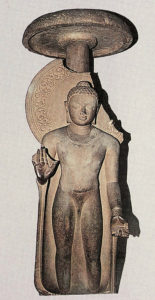
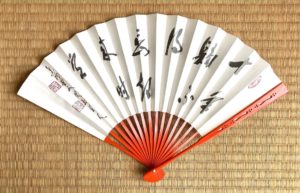
The Kanji 傘, is composed of characters representing person, hito, 人, that resembles the Kanji for eight, hachi, 八. In Japan, age 80 is called kasa-ju, 傘寿, umbrella-longevity. Curiously, the Buddha died at the age of 80.
The Precious Parasol is one of the Eight Auspicious Symbols in Buddhism, represents protection from suffering and obstacles. Jizō’s straw kasa protects him from snow and rain. The lid of the kama on a futa-oki, 蓋置, lid-place, resembles a chatra.
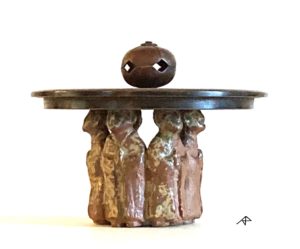
For further study see also: Tea in April, April in Japan: Following Elephants

